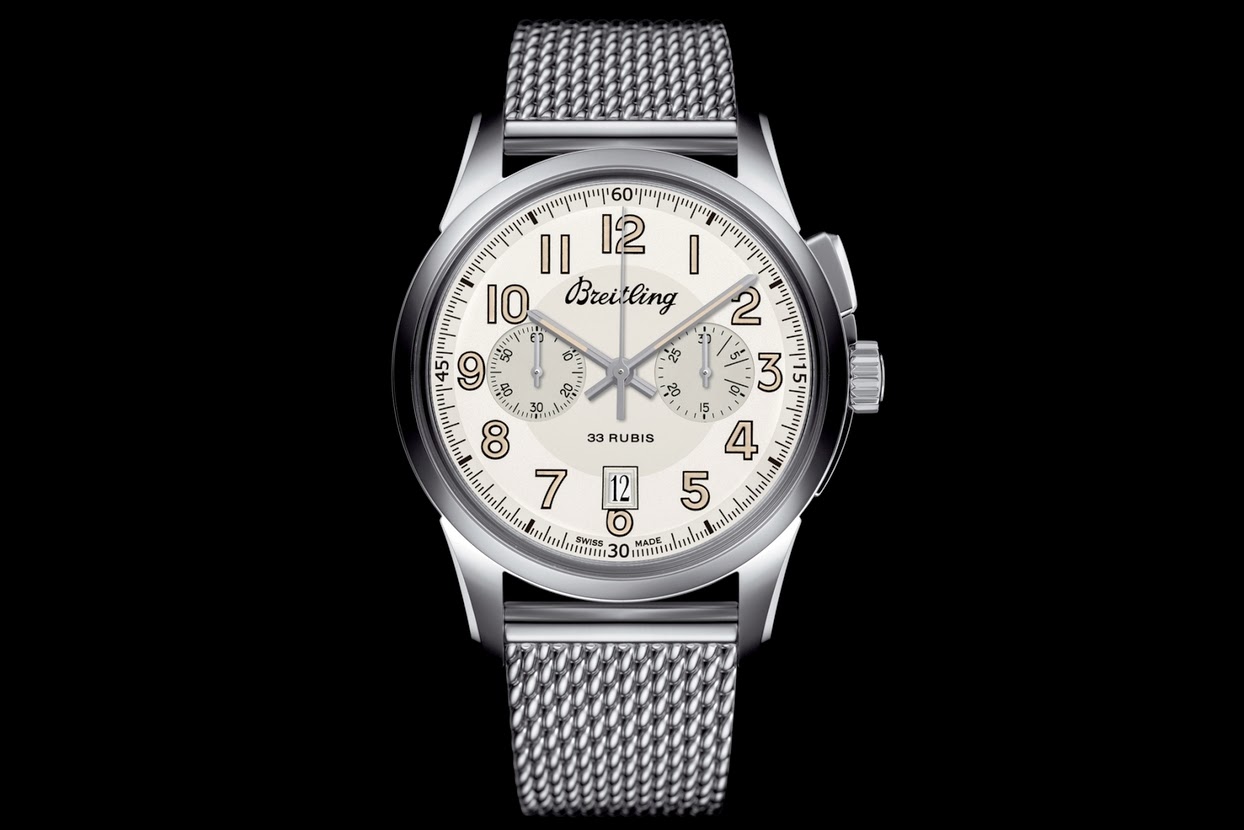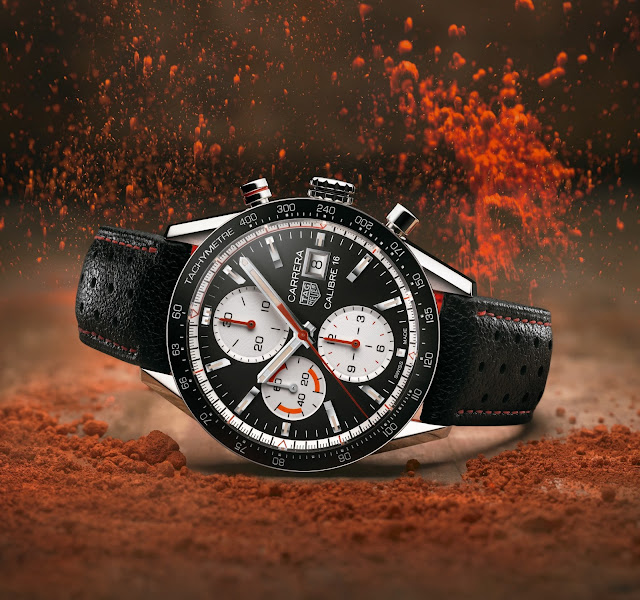NUEVO BREITLING TRANSOCEAN CHRONOGRAPH 1915, UN CRONOGRAFO CON SABOR VINTAGE
100 aniversario de una invención de capital
Hace un siglo, Breitling creó el primer cronógrafo pulsador independiente. Para celebrar este hito invención que iba a cambiar la faz del cronógrafo, la marca es la introducción de una serie limitada de su modelo de Transocean, con un nuevo y exclusivo calibre Breitling Manufactura y un diseño inusual reinterpretación del famoso pulsador 1915.
Hace un siglo, Breitling creó el primer cronógrafo pulsador independiente. Para celebrar este hito invención que iba a cambiar la faz del cronógrafo, la marca es la introducción de una serie limitada de su modelo de Transocean, con un nuevo y exclusivo calibre Breitling Manufactura y un diseño inusual reinterpretación del famoso pulsador 1915.
Los cronógrafos de bolsillo tenían un solo pulsador, ubicado en la corona y enviaban sucesivamente la marcha, paro y funciones cero de reposición. En 1915, Breitling - un especialista en relojes técnicos - fue una de las primeras marcas para ofrecer un cronógrafo de pulsera. Pero en la reubicación desde el bolsillo del chaleco a la muñeca, la empresa introdujo una innovación que no pasó desapercibido. El hijo del fundador, Gaston Breitling, se le ocurrió la genial idea de asegurar una separación más clara de las funciones mediante la creación de un pulsador independiente de la corona para el control de las tres operaciones del cronógrafo. Keen para asegurar un manejo suave y ergonómico, optó por colocar el pulsador a las 2 de la tarde, donde el pulgar o el índice descansa naturalmente, si el reloj se encuentra en la muñeca o en la palma de la mano. En 1923, Breitling perfeccionado este sistema mediante la separación de las funciones de parada / arranque, que se rigen por el pulsador a las 2 de la tarde, a partir de la cero-reajuste corona activadas. Esta innovación patentada que los usuarios podrán agregar hasta varias veces sucesivas sin necesidad de reponer las manecillas a cero - si temporización una competición deportiva, un proceso científico o un tiempo de vuelo. Por último, en 1934, Breitling dio el paso final en la conformación de la cara moderna del cronógrafo mediante la creación del segundo pulsador independiente destinada exclusivamente a cero puesta a cero. Esta invención patentada pronto fue adoptada por todos sus competidores.
Un cronógrafo monopulsador con rueda doble columna
Para celebrar este importante hito en su historia, y la historia de la relojería, Breitling ha creado el Transocean Cronógraph 1915. Lejos de contentarse con una simple reedición del modelo original, la firma ha optado por reinterpretarlo tanto técnica y estética ángulos. La caja de acero, diseñado en el estilo puro de la colección de Transocean y alberga el famoso pulsador a las 2 horas, pero expresada en una forma rediseñada, alargada y suavemente integrado que mejora aún más su funcionalidad. La preocupación por la comodidad y la ergonomía que sin duda le hubiera gustado Gaston Breitling. Para asegurarse de que este único pulsador puede manejar sucesivamente la marcha, paro y funciones cero-reset, los relojeros e ingenieros Breitling han desarrollado la nueva cuerda manual Manufactura Calibre Breitling B14, oficialmente cronómetro certificado, equipado con un ingenioso doble columna de dos niveles -wheel sistema activado por los controles del cronógrafo también distribuye en dos niveles.
Una patente ha sido presentada para esta construcción innovadora. La esfera plateada de doble zona con segundero pequeño y contador de 30 minutos está adornada con grandes números arábigos y de tipo bastón, las manillas acentuados por un revestimiento luminiscente en una sombra patinado atractivo. Un toque vintage reforzada por la firma histórica Breitling y el brazalete de malla de acero. Una caja de zafiro permite a uno para admirar la construcción inusual del movimiento cronógrafo monopulsador, junto con el "anniversaire 100e 1915-2015" (100 aniversario 1915-2015) grabado. Este modelo se emite en una serie limitada de 1.915. Una pieza de coleccionista para todos los amantes del cronógrafo.
Calibre: Breitling
B14 (Manufacture)
Movimiento: Mecanico, manual.
Power reserve: Min.
70 hrs
Cronógrafo: 1/4th
segundo 30 minutos.
Alternancias:28
800 alt/h
Rubíes: 33
Calendario. Dial aperture
Caja: Acero
Fondo: transparente cristal de zafiro
Resistencia al agua: 100 metros (330 ft/10 bars)
Cristal
zafiro convexo.
Diametro: 43.00 mm
Correa:
Cuero o Ocean Classic
100th anniversary of a capital invention
One century ago, Breitling created the first independent
chronograph pushpiece. To celebrate this milestone invention that was to change
the face of the chronograph, the brand is introducing a limited series of its
Transocean model, with an exclusive new Manufacture Breitling caliber and an
unusual design reinterpreting the famous 1915 pushpiece.
Pocket chronographs had only one pushpiece, housed in the
crown and successively handling the start, stop and zero-reset functions. In
1915, Breitling – a specialist in technical watches – was one of the very first
brands to offer a wrist chronograph. But in relocating it from the waistcoat
pocket to the wrist, the firm introduced an innovation that did not go
unnoticed. The founder’s son, Gaston Breitling, came up with the ingenious idea
of ensuring a clearer separation of functions by creating a pushpiece
independent of the crown to control the three chronograph operations. Keen to
ensure smooth, ergonomic handling, he chose to place the pushpiece at 2
o’clock, where the thumb or forefinger naturally rests, whether the watch is on
the wrist or held in the palm of the hand. In 1923, Breitling perfected this
system by separating the stop/start functions, governed by the pushpiece at 2
o’clock, from the crown-activated zero-resetting. This patented innovation
would enable users to add up several successive times without needing to reset
the hands to zero – whether timing a sports competition, a scientific process
or a flight time. Finally, in 1934, Breitling took the final step in shaping
the modern face of the chronograph by creating the second independent pushpiece
exclusively intended for zero-resetting. This patented invention was soon
adopted by all its competitors.
A monopusher chronograph with double column wheel
To celebrate this major milestone in its history, and the
history of watchmaking, Breitling has created the Transocean Chronograph 1915.
Far from contenting itself with a mere re-edition of the original model, the
firm has chosen to reinterpret it from both technical and aesthetic angles. The
steel case, designed in the pure style of the Transocean collection, features
the famous pushpiece at 2 o’clock, but expressed in a redesigned, elongated and
smoothly integrated form that further enhances its functionality. A concern for
comfort and ergonomics that would doubtless have pleased Gaston Breitling. To
ensure that this single pushpiece can successively handle the start, stop and
zero-reset functions, the Breitling watchmakers and engineers have developed
the new hand-wound Manufacture Breitling Caliber B14, officially
chronometer-certified, equipped with a clever two-tiered double column-wheel
system activated by chronograph controls also arranged on two levels.
A patent has been filed for this innovative construction.
The twin-zone silvered dial with small seconds and 30-minute counter is adorned
with large Arabic numerals and baton-type hands accentuated by a luminescent
coating in an appealing patinated shade. A vintage touch reinforced by the
historical Breitling signature and the steel mesh bracelet. A sapphire caseback
enables one to admire the unusual construction of the monopusher chronograph
movement, along with the “100e anniversaire 1915-2015” (100th anniversary
1915-2015) engraving. This model is issued in a limited series of 1,915. A
collector’s piece for all chronograph lovers.






Comentarios
Publicar un comentario